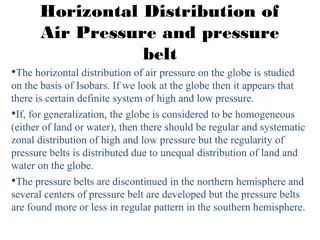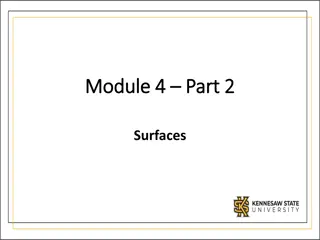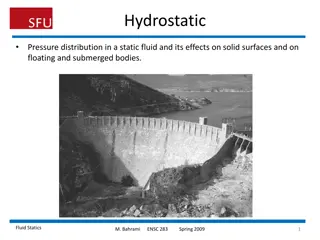Understanding Pressure Surfaces and Environmental Lapse Rates in Meteorology
This content discusses how pressure surfaces slope from low to high latitudes due to temperature changes, calculating the slope of pressure surfaces at different latitudes, determining wind speed based on slope, computing environmental lapse rates, and analyzing stability using dry and moist adiabatic ascent in meteorology. It provides insights into key concepts and their practical applications in weather forecasting and atmospheric studies.
Download Presentation

Please find below an Image/Link to download the presentation.
The content on the website is provided AS IS for your information and personal use only. It may not be sold, licensed, or shared on other websites without obtaining consent from the author. Download presentation by click this link. If you encounter any issues during the download, it is possible that the publisher has removed the file from their server.
E N D
Presentation Transcript
Meteo 3 Lab 6 October 16, 2019
Problem 7.12 Pressure Surfaces slope downward from low latitudes (equator) to high latitudes (poles) because temperature decreases. Height (m) 1540 m 1360 m Compute the slope of each pressure surface 70 oN 25 oN N. Pole Equator
Problem 7.12 1540 m Example: 850 mb level 1360 m Change in height change in distance Slope = 25 oN 70 oN Slope = Height at 25o Height at 70o Distance between latitudes We need units of m per 100km 1o latitude = 111 km Slope = 1540m 1360m 25o 70o 25o 70o = -45o -45o * 111 km = -4,995 km -4,995 / 100 = -49.95 (km*100) 180 (m) Slope = 49.95(km 100) Slope = -3.6 m per 100 km
Problem 7.12 At what level does the slope reach a maximum? What does this say about wind speed at this level? The bigger the difference in pressure/height (the bigger the slope), the faster the wind speed! Increasing wind speed
Problem 8.1 Compute the environmental lapse rate Lapse rate: change in temperature with altitude (units: oC/m) Lapse Rate = Change in temperature from bottom to top of layer thickness of layer Height Above Ground (m) 2500 m 3000 m Temperature (oC) 13 9 13 oC 9 oC |2500 3000m|= 4 oC 500 m Lapse Rate = Convert 1000m = 1km Lapse Rate = 8 oC/km
Problem 8.1 Is the layer stable, unstable, or conditionally unstable? Compare the environmental lapse rate to the dry adiabatic lapse rate (10 oC/km) and moist adiabatic lapse rates (6 oC/km) Stable Environmental Lapse Rate < 6 C/km Parcel will sink (if displaced) Parcel could rise if it becomes saturated Parcel will rise (if displaced) Conditionally Unstable 6 C/km < Environmental Lapse Rate < 10 C/km Unstable Environmental Lapse Rate > 10 C/km Example 6 oC/km < 8 oC/km < 10 oC/km Conditionally Unstable Environmental Lapse Rate = 8 oC/km
Problem 8.1 Check stability assuming both dry adiabatic and moist adiabatic ascent 3000m Example 9oC Dry Adiabatic Lapse Rate = -10 oC/km Parcel lifted 0.5km, so it cools by -5oC. Temperature at top of layer is 8oC. (13-5) 8oC < 9oC. Negatively buoyant (sinks) parcel Moist Adiabatic Lapse Rate = -6 oC/km 2500m Parcel lifted 0.5km, so it cools by -3oC. 13 oC Temperature at top of layer is 10oC. (13-3) Assume the parcel starts at 13oC 10oC > 9oC. Positively buoyant (rises) VERDICT: Conditionally Unstable
Problem 8.7 Cabin air pressure = 820mb at altitude 1.8 km You re on a plane at altitude = 9.5km Outside Air Pressure = 300mb Outside Temperature = -40oC What is the temperature when the air is pressurized? Think of an air parcel descending from 9.5km (at -40oC) to 1.8km. Parcel will warm at dry adiabatic lapse rate (10oC/km) Calculate the temperature change in that descent using the dry adiabatic lapse rate Would the air need to be heated or cooled to be comfortable? Is the temperature from (a) comfortable? Compare to the average room temperature, 20oC - 25oC [68oF 77oF].
Problem 8.9 Marine Layer: shallow deck of low clouds Is the Marine Layer stable or unstable? Look at the image for reference Cloud appearance gives clues to stability: Bubbly (cumulus) = stable or unstable? Flat (stratus) = stable or unstable? Is fog and haze more likely to form in unstable or stable layers? Is there a temperature inversion? Temperature inversion: temperature INCREASES with altitude (opposite of normal) Water Temperature = 60-65oF Inland Temperature = 75-80oF Check the temperature column of the chart
Problem 8.11 Describe where there are clouds and no clouds Time of day (morning/afternoon)? Season? Think about the temperature difference of the water and land during the seasons. Would temperature impact cloud formation? The clouds are convective cumulus . What does this say about stability? What time of day would these clouds appear?
Problem 9.2 Speed of sound depends, in part, on the air temperature ????? ?? ????? = 20 ? *this is an approximate equation, so units do not work out exactly Estimate the amount of time that would elapse between seeing lightning and hearing thunder First convert from Fahrenheit to Kelvin Solve for speed of sound (units = m/s) Solve for # of seconds knowing the distance away (5 km or 5000 m) Distance Speed of Sound Time Elapsed =
Problem 9.6 Calculate the height of the cloud base A rising unsaturated parcel cools at the dry adiabatic lapse rate (10oC/km) The height of the cloud base is where the parcel temperature falls to the dew point What 2 cities would have the most forest fires triggered by thunderstorms? Think about the rainfall that would put out the fires The relative humidity below the cloud base is <100%, so what will happen to the raindrops as they fall, especially if cloud base is very high and raindrops fall a long way through dry (unsaturated) air?























